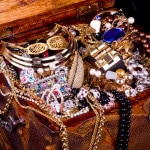History and origin of the jewellery
 Today, almost everyone wears jewellery, but doesn't care about its origin, age or history. After all, jewellery is as old as humanity itself. Since ancient times, we feel the urge to adorn ourselves, whether to express wealth, symbolize power or simply because we like these sparkling objects.
The first jewellery was not an accessory
in the way we understand it today. Instead, the very first jewellery can be described as body paint, which was made from plant juices, different minerals and crushed soil. Natives still decorate themselves in this ancestral tradition. While the first shapes and colors were chosen rather arbitrarily, a symbolism developed over time, representing, for example, a person's social status. Hence, several thousand years ago, only medicine men and chiefs were allowed to wear jewellery. Later, people learned to make jewellery from bones, stones and feathers.
This is how people developed jewellery over the years. This commodity had no practical utility value, but instead served an important "end in itself". Its peak was reached only in the days of emperors and kings. Today, jewellery is seen not only as an accessory, but also as an alternative to risky financial investments.
Today, almost everyone wears jewellery, but doesn't care about its origin, age or history. After all, jewellery is as old as humanity itself. Since ancient times, we feel the urge to adorn ourselves, whether to express wealth, symbolize power or simply because we like these sparkling objects.
The first jewellery was not an accessory
in the way we understand it today. Instead, the very first jewellery can be described as body paint, which was made from plant juices, different minerals and crushed soil. Natives still decorate themselves in this ancestral tradition. While the first shapes and colors were chosen rather arbitrarily, a symbolism developed over time, representing, for example, a person's social status. Hence, several thousand years ago, only medicine men and chiefs were allowed to wear jewellery. Later, people learned to make jewellery from bones, stones and feathers.
This is how people developed jewellery over the years. This commodity had no practical utility value, but instead served an important "end in itself". Its peak was reached only in the days of emperors and kings. Today, jewellery is seen not only as an accessory, but also as an alternative to risky financial investments.
The controversial history of jewellery
Findings in Morocco indicate that shells were perforated over 75’000 years ago and tied together on rope to form a chain. Color pigments even show that the shells were painted. Further discoveries are supposed to prove that jewellery was worn simultaneously on all continents during the Lower Paleolithic period, 50’000 years ago. Archaeologists assume that people wore jewellery to show their status to foreigners. Spanish philosopher Fernando Savater, on the other hand, is convinced that prehistoric peoples recognized their mortality and wanted to show through jewellery that they were happy and still alive. In 30’000 BC European hunters wore charms made from the bones and teeth of their prey. These pendants were not just simple jewellery, but also a talisman that was supposed to bring them luck. The jewellery of this time was very simple due to the limited technical possibilities. For the next 20’000 years, stone pearls were enough for mankind, and other forms of jewellery were not developed.
Jewellery in the year 4’000 BC
It was only when people invented metalworking that jewellery production changed radically. In the 4th millennium, jewellery played an important role in Egyptian life, adding a colorful accent to the white linen clothes. Jewellery also played a central role in the belief in the dead Egypt and the southern regions were the main sources of gold in antiquity, providing the mummies of the pharaohs with a wealth of gold and other jewels.The dead were not only decorated with the jewels they had worn during their lifetime, but also with specially crafted pieces. Egyptian jewelers produced mainly amulets . The variety was rather limited, but the items had a magical-religious meaning, which was more important than their decorative value. The scarab was the most popular symbol of this period: it symbolized the sun and the incarnation of divinity.
Jewellery today
Thanks to the discovery of metalworking, the manufacture of glass and the development of new fabrics and materials in the 20th century, jewellery is now made in a wide variety of shapes, colors and sizes. Jewellery is no longer made exclusively from rare materials, but also from cheaper materials which are available in large quantities. Common materials used today include gold, silver, jewels and stones. Jewellery is divided into different categories:
Body part & jewellery type:
- Necklaces
- Chains
- Colliers
- Pendants
- Wrist and finger jewellery
- Bracelets
- Bangles
- Baby engraving bracelets
- Rings
- Couple rings
- Engagement rings
- Wedding rings
- Memoire rings
- Earrings
- Stud earrings
- Drop Earrings
- Hoop Earrings
- All body parts
- Piercings
Jewellery material:
- Diamond
- Gemstones (ruby, sapphire, emerald)
- Zirconia
- Gold
- Yellow gold
- White gold
- Rosé gold
- Silver
- Stainless steel
- Pearls
- Palladium
- Titan
- Carbon
Today it is possible to decorate practically any part of the body . Years ago, for example, there was a boom in piercings that adorned the nose, mouth and other parts of the body. Today, jewellery is an integral part of any wardrobe. Whether for men, women or children. There is a wide selection of jewellery to suit every taste and budget.
Article image: © Forewer / Shutterstock







